Are you looking to enhance your Spanish language skills? At COMPARE.EDU.VN, we understand the importance of mastering comparatives and superlatives in Spanish. This comprehensive guide will provide you with everything you need to confidently compare and contrast in Spanish, elevating your fluency and understanding.
1. Understanding Comparatives and Superlatives in Spanish
Comparative and superlative adjectives are essential tools for expressing degrees of qualities and comparing different entities in Spanish. Comparatives allow you to compare two things, highlighting their similarities or differences. Superlatives, on the other hand, enable you to identify the extreme degree of a quality among a group of three or more items.
- Comparatives: Used to compare two nouns.
- Superlatives: Used to compare three or more nouns to find the extreme.
2. Types of Comparatives in Spanish
There are two main types of comparatives in Spanish: comparatives of inequality and comparatives of equality. Each type uses a specific structure to express the comparison.
2.1 Comparatives of Inequality
Comparatives of inequality are used to indicate that one thing is either more or less than another. The structure for these comparatives involves using “más” (more) or “menos” (less) along with the adjective and the word “que” (than).
- More than: más + adjective + que
- Less than: menos + adjective + que
Examples:
- Mi coche es más rápido que el tuyo. (My car is faster than yours.)
- Este libro es menos interesante que el otro. (This book is less interesting than the other.)
2.2 Comparatives of Equality
Comparatives of equality are used to express that two things are equal in a certain way. The structure for these comparatives involves using “tan” (as) along with the adjective and the word “como” (as).
- tan + adjective + como
Examples:
- Ella es tan alta como su hermana. (She is as tall as her sister.)
- Este restaurante es tan bueno como el otro. (This restaurant is as good as the other.)
3. Irregular Comparatives in Spanish
Some adjectives have irregular comparative forms that do not follow the standard structure. These irregular forms are important to memorize as they are commonly used.
3.1 Common Irregular Comparatives
Here are some of the most common irregular comparatives in Spanish:
| Adjective | Irregular Comparative | Translation |
|---|---|---|
| Bueno (good) | Mejor | Better |
| Malo (bad) | Peor | Worse |
| Grande (big) | Mayor | Bigger/Older |
| Pequeño (small) | Menor | Smaller/Younger |
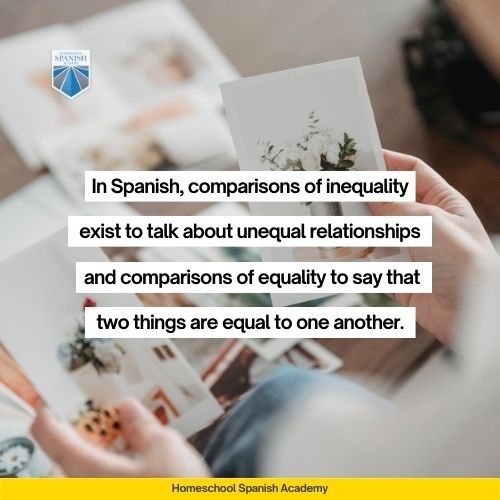

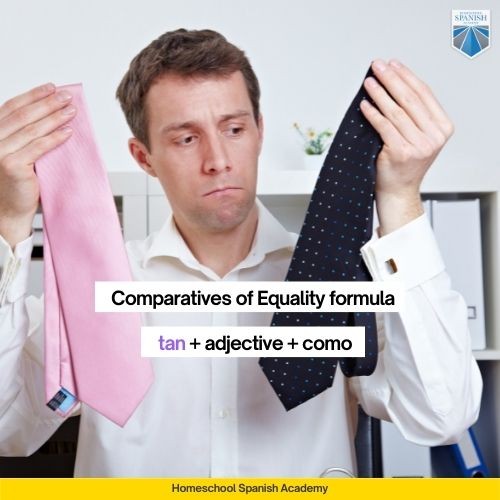
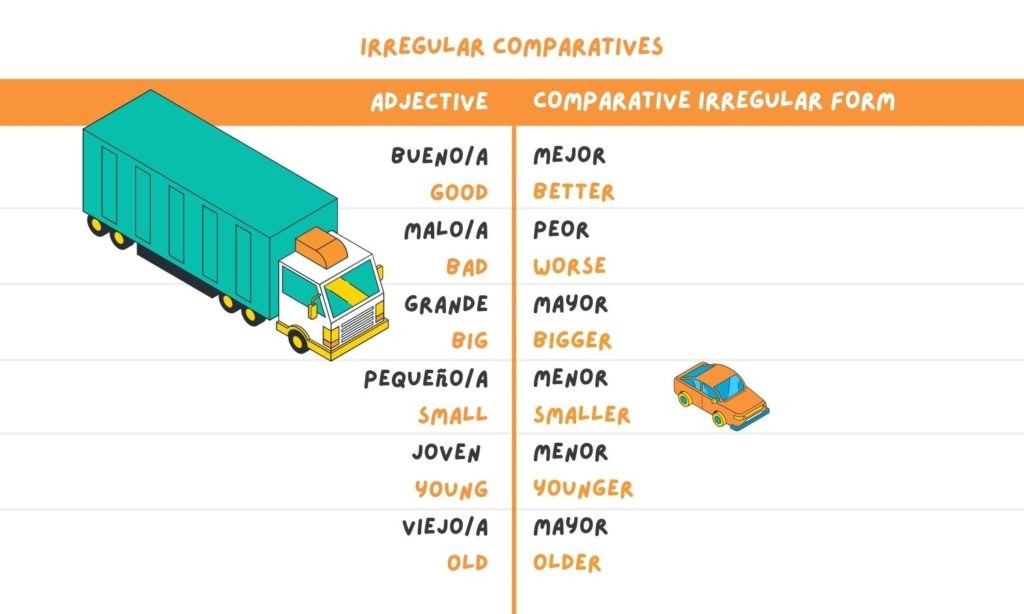
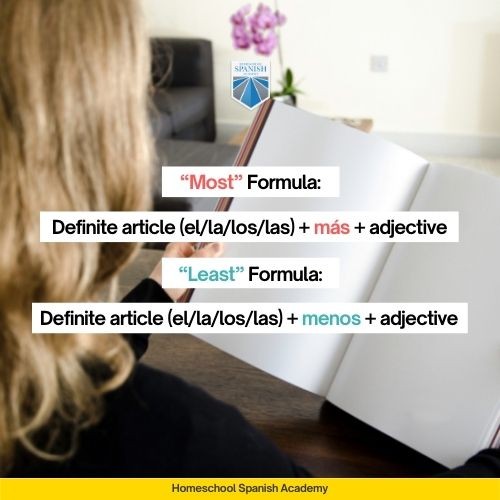
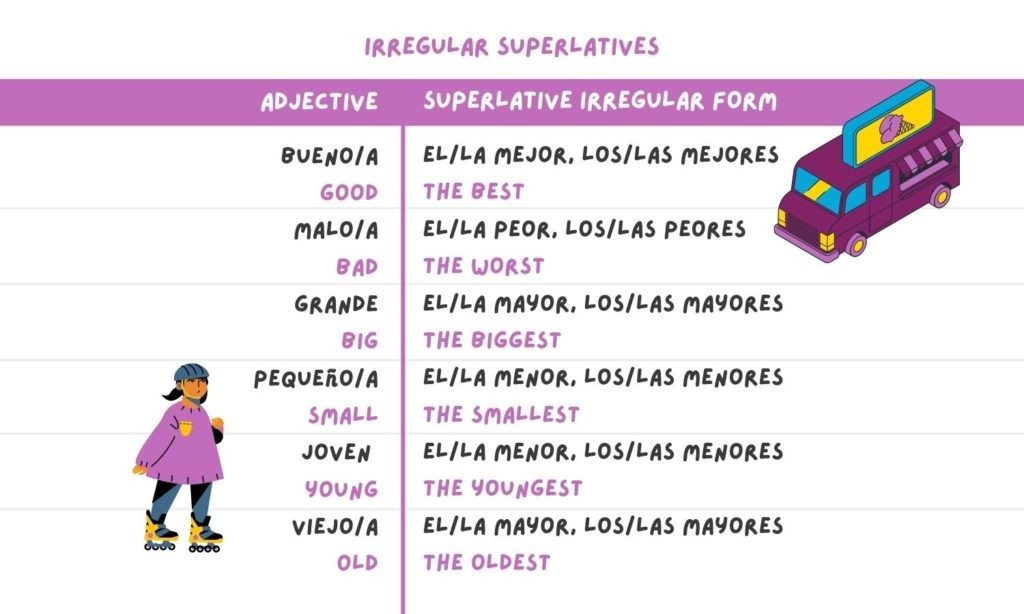




Examples:
- Este pastel es mejor que el de ayer. (This cake is better than yesterday’s.)
- Su situación es peor que la mía. (His/Her situation is worse than mine.)
4. Superlatives in Spanish
Superlatives are used to express the highest or lowest degree of a quality among a group of three or more items. The structure for superlatives involves using the definite article (el, la, los, las) along with “más” (most) or “menos” (least) and the adjective.
4.1 Forming Superlatives
- Most: el/la/los/las + más + adjective
- Least: el/la/los/las + menos + adjective
Examples:
- Ella es la más inteligente de la clase. (She is the most intelligent in the class.)
- Este es el menos caro de los restaurantes. (This is the least expensive of the restaurants.)
4.2 Irregular Superlatives
Just like comparatives, some adjectives have irregular superlative forms. These forms also require memorization for accurate usage.
4.3 Common Irregular Superlatives
| Adjective | Irregular Superlative | Translation |
|---|---|---|
| Bueno (good) | El/La mejor | The best |
| Malo (bad) | El/La peor | The worst |
| Grande (big) | El/La mayor | The biggest/oldest |
| Pequeño (small) | El/La menor | The smallest/youngest |
Examples:
- Este es el mejor restaurante de la ciudad. (This is the best restaurant in the city.)
- Fue la peor experiencia de mi vida. (It was the worst experience of my life.)
5. Additional Ways to Express Superlatives
Spanish offers additional ways to express superlatives, often adding emphasis or emotional tone to the comparison. One common method is using the suffix “-ísimo” or “-ísima” to an adjective.
5.1 Using -ísimo/-ísima
Adding “-ísimo” (masculine) or “-ísima” (feminine) to the end of an adjective emphasizes its superlative quality, similar to adding “very” or “extremely” in English.
To use this suffix correctly, you typically drop the final vowel of the adjective before adding “-ísimo” or “-ísima.” However, there are some spelling changes to consider:
- If the adjective ends in “-ble,” change it to “-bil” before adding “-ísimo” or “-ísima.”
- If the adjective ends in “-n,” “-dor,” or “-or,” change “-ísimo” to “-císimo” or “-ísima” to “-císima.”
- Some adjectives that have the letter “r” in the final syllable will have the “-érrimo” ending instead of “-ísimo.”
Examples:
- Alto (tall) → Altísimo (extremely tall)
- Bajo (short) → Bajísimo (extremely short)
- Fácil (easy) → Facilísimo (extremely easy)
- Amable (kind) → Amabilísimo (very kind)
- Trabajador (hardworking) → Trabajadorcísimo (extremely hardworking)
- Libre (free) → Liberísimo (extremely free)
6. Using Comparatives and Superlatives with Adverbs
Comparatives and superlatives are not limited to adjectives; they can also be used with adverbs to compare or emphasize the manner in which actions are performed.
6.1 Comparative Adverbs
To form comparative adverbs, use “más” (more) or “menos” (less) before the adverb, followed by “que” (than).
Examples:
- Ella habla más rápido que él. (She speaks faster than him.)
- Él trabaja menos eficientemente que ella. (He works less efficiently than her.)
6.2 Superlative Adverbs
To form superlative adverbs, use “lo” before “más” (most) or “menos” (least) and the adverb.
Examples:
- Ella corre lo más rápido posible. (She runs as fast as possible.)
- Él trabaja lo menos eficientemente posible. (He works as inefficiently as possible.)
7. Key Differences and Nuances
Mastering comparatives and superlatives in Spanish requires understanding several key differences and nuances.
7.1 Agreement with Gender and Number
Both comparatives and superlatives must agree in gender (masculine or feminine) and number (singular or plural) with the nouns they modify. This agreement extends to the articles (el, la, los, las) and adjectives used in the comparison.
Examples:
- El libro es más interesante que la revista. (The book is more interesting than the magazine.) – Masculine singular noun (libro) and feminine singular noun (revista).
- Las manzanas son menos caras que las peras. (The apples are less expensive than the pears.) – Feminine plural nouns (manzanas and peras).
7.2 Contextual Usage
The choice between comparative and superlative forms often depends on the context of the comparison. Use comparatives when comparing two items and superlatives when comparing three or more.
Examples:
- Comparative: Este coche es más rápido que aquel. (This car is faster than that one.)
- Superlative: Este es el coche más rápido de todos. (This is the fastest car of all.)
7.3 Formal vs. Informal Usage
In formal Spanish, it is common to use the irregular comparative and superlative forms (mejor, peor, mayor, menor). However, in informal speech, you might hear “más bueno/a” or “más malo/a,” although these are generally considered less correct.
Examples:
- Formal: Este es el mejor restaurante. (This is the best restaurant.)
- Informal: Este es el más bueno restaurante. (This is the most good restaurant.) – Less common and less formal.
7.4 Regional Variations
The usage of certain comparative and superlative forms can vary by region. For example, in some Latin American countries, the use of “más grande” or “más pequeño” may be more common than “mayor” or “menor,” even though the latter are technically more correct according to Spanish grammar.
Examples:
- Spain: Él es mayor que yo. (He is older than me.)
- Latin America: Él es más grande que yo. (He is bigger/older than me.) – Usage varies depending on the specific country.
8. Common Mistakes to Avoid
Learning to use comparatives and superlatives correctly in Spanish requires awareness of common mistakes. By understanding these pitfalls, you can improve your accuracy and fluency.
8.1 Incorrect Gender and Number Agreement
One of the most common errors is failing to make the adjective and article agree in gender and number with the noun being described.
Example of Incorrect Usage:
El libro es la más interesante. (The book is the most interesting.)
Correct Usage:
El libro es el más interesante. (The book is the most interesting.)
Explanation:
“Libro” is masculine singular, so the article must be “el” and the adjective must agree in the masculine singular form.
8.2 Misusing “Ser” and “Estar”
Using the wrong verb with comparative and superlative adjectives can change the meaning of the sentence. “Ser” is generally used for permanent or inherent characteristics, while “estar” is used for temporary states or conditions.
Example of Incorrect Usage:
Este restaurante está el mejor de la ciudad. (This restaurant is being the best in the city.)
Correct Usage:
Este restaurante es el mejor de la ciudad. (This restaurant is the best in the city.)
Explanation:
“Ser” is appropriate here because you are describing an inherent quality of the restaurant (its ranking).
8.3 Overusing “Más Bueno/a” and “Más Malo/a”
While using “más bueno/a” and “más malo/a” is common in informal speech, it is grammatically preferable to use “mejor” and “peor.”
Example of Incorrect Usage:
Este pastel es más bueno que el otro. (This cake is more good than the other.)
Correct Usage:
Este pastel es mejor que el otro. (This cake is better than the other.)
Explanation:
“Mejor” is the correct comparative form of “bueno.”
9. Practical Exercises and Examples
To solidify your understanding of comparatives and superlatives in Spanish, let’s go through some practical exercises and examples.
9.1 Completing Sentences
Fill in the blanks with the correct comparative or superlative form of the adjective provided.
- Este coche es ________ (rápido) que el mío.
- Ella es ________ (inteligente) de la clase.
- Mi casa es ________ (grande) que la tuya.
- Este libro es ________ (interesante) de todos.
- Él es ________ (alto) de su familia.
Answers:
- más rápido
- la más inteligente
- más grande
- el más interesante
- el más alto
9.2 Translating Sentences
Translate the following sentences into Spanish using comparatives and superlatives.
- This movie is better than the one we saw last week.
- She is the most hardworking student in the school.
- My dog is smaller than yours.
- This is the worst day of my life.
- He is as tall as his father.
Answers:
- Esta película es mejor que la que vimos la semana pasada.
- Ella es la estudiante más trabajadora de la escuela.
- Mi perro es más pequeño que el tuyo.
- Este es el peor día de mi vida.
- Él es tan alto como su padre.
9.3 Error Correction
Identify and correct the errors in the following sentences.
- Ella es más buena que su hermana.
- Este es el más mejor libro que he leído.
- Mi casa está el más grande de la calle.
- Las manzanas son más caro que las naranjas.
- Él es la más inteligente del grupo.
Corrected Sentences:
- Ella es mejor que su hermana.
- Este es el mejor libro que he leído.
- Mi casa es la más grande de la calle.
- Las manzanas son más caras que las naranjas.
- Él es el más inteligente del grupo.
10. Resources for Further Learning
To continue improving your understanding and usage of comparatives and superlatives in Spanish, here are some helpful resources.
- Online Courses: Platforms like Coursera, Udemy, and edX offer courses on Spanish grammar and vocabulary.
- Language Learning Apps: Apps such as Duolingo, Babbel, and Memrise provide interactive lessons and exercises.
- Textbooks: Use Spanish grammar textbooks to get a comprehensive overview of the rules and usage.
- Language Exchange Partners: Practice speaking with native Spanish speakers through language exchange websites or apps like Tandem and HelloTalk.
- Spanish-Language Media: Watch Spanish movies, TV shows, and listen to podcasts to immerse yourself in the language and see comparatives and superlatives used in context.
11. Why Mastering Comparatives and Superlatives Matters
Understanding and correctly using comparatives and superlatives in Spanish is crucial for effective communication.
11.1 Enhancing Fluency
Mastering these grammatical structures allows you to express more complex ideas and make nuanced comparisons, which contributes to smoother and more natural conversations.
11.2 Improving Comprehension
Recognizing comparative and superlative forms helps you better understand spoken and written Spanish, especially when dealing with descriptions and evaluations.
11.3 Increasing Confidence
Accurate usage of comparatives and superlatives demonstrates a higher level of linguistic competence, which can boost your confidence in using Spanish in various settings.
11.4 Avoiding Misunderstandings
Using these forms correctly ensures that your intended meaning is clear, reducing the risk of miscommunication or confusion.
11.5 Cultural Competence
Demonstrating proficiency in Spanish, including grammatical nuances like comparatives and superlatives, shows respect for the language and culture, fostering better relationships with native speakers.
12. Conclusion: Elevate Your Spanish Proficiency
Mastering comparatives and superlatives in Spanish is essential for achieving fluency and precision in your language skills. By understanding the rules, practicing regularly, and utilizing available resources, you can confidently express comparisons and superlatives in Spanish. Whether you’re a student, traveler, or professional, investing time in learning these grammatical structures will significantly enhance your ability to communicate effectively in Spanish.
Ready to take your Spanish to the next level? Visit COMPARE.EDU.VN for more detailed guides, practical exercises, and resources to help you master Spanish comparatives and superlatives. At COMPARE.EDU.VN, we provide the comparisons you need to make informed decisions, including language learning resources.
13. Call to Action
Don’t let language barriers hold you back. Visit COMPARE.EDU.VN today to discover the best Spanish language learning resources and embark on your journey to fluency. Whether you’re comparing language courses, textbooks, or online tools, COMPARE.EDU.VN provides the detailed, objective comparisons you need to make the right choice.
For personalized assistance or further inquiries, contact us at 333 Comparison Plaza, Choice City, CA 90210, United States. You can also reach us via Whatsapp at +1 (626) 555-9090 or visit our website at COMPARE.EDU.VN. Let us help you make informed decisions and achieve your language learning goals.
14. FAQ: Mastering Comparatives and Superlatives in Spanish
14.1 What are comparatives and superlatives in Spanish?
Comparatives are used to compare two things, indicating whether one is more or less than the other in a specific quality. Superlatives are used to express the highest or lowest degree of a quality among a group of three or more items.
14.2 How do you form comparatives of inequality in Spanish?
To form comparatives of inequality, use “más” (more) or “menos” (less) along with the adjective and the word “que” (than). For example, “más rápido que” (faster than) or “menos interesante que” (less interesting than).
14.3 How do you form comparatives of equality in Spanish?
To form comparatives of equality, use “tan” (as) along with the adjective and the word “como” (as). For example, “tan alto como” (as tall as).
14.4 What are some common irregular comparatives in Spanish?
Common irregular comparatives include “mejor” (better) for “bueno” (good), “peor” (worse) for “malo” (bad), “mayor” (bigger/older) for “grande” (big), and “menor” (smaller/younger) for “pequeño” (small).
14.5 How do you form superlatives in Spanish?
To form superlatives, use the definite article (el, la, los, las) along with “más” (most) or “menos” (least) and the adjective. For example, “el más inteligente” (the most intelligent).
14.6 Are there irregular superlatives in Spanish?
Yes, there are irregular superlatives. They correspond to the irregular comparatives, such as “el/la mejor” (the best) for “bueno” (good) and “el/la peor” (the worst) for “malo” (bad).
14.7 How do you use “-ísimo” in Spanish?
Adding “-ísimo” (masculine) or “-ísima” (feminine) to the end of an adjective emphasizes its superlative quality, similar to adding “very” or “extremely” in English. For example, “altísimo” (extremely tall).
14.8 Do comparatives and superlatives need to agree in gender and number?
Yes, comparatives and superlatives must agree in gender (masculine or feminine) and number (singular or plural) with the nouns they modify.
14.9 What are some common mistakes to avoid when using comparatives and superlatives?
Common mistakes include incorrect gender and number agreement, misusing “ser” and “estar,” and overusing “más bueno/a” and “más malo/a” instead of “mejor” and “peor.”
14.10 Where can I find more resources to learn about comparatives and superlatives in Spanish?
You can find more resources at compare.edu.vn, online courses, language learning apps, textbooks, language exchange partners, and Spanish-language media.
